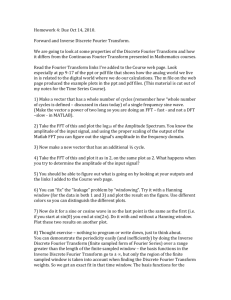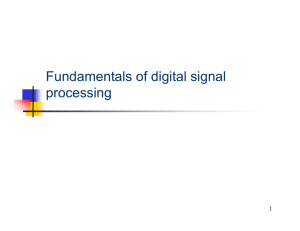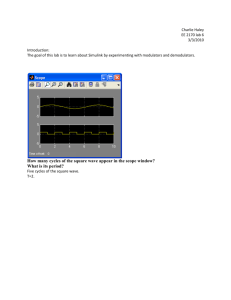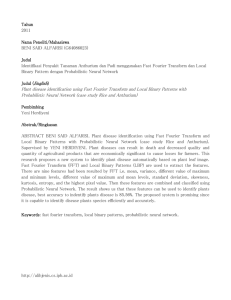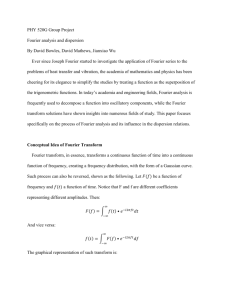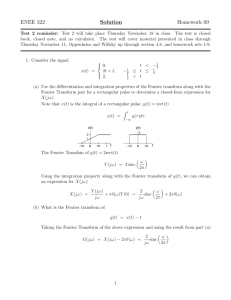Introduction to Digital Communication Systems
advertisement
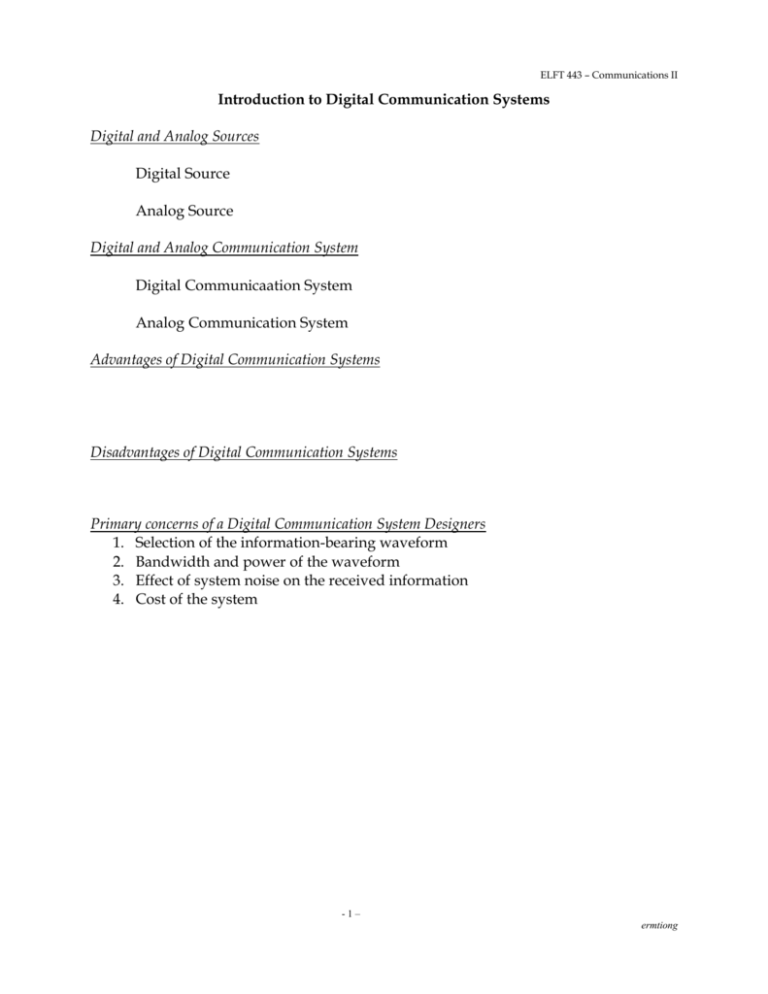
ELFT 443 – Communications II
Introduction to Digital Communication Systems
Digital and Analog Sources
Digital Source
Analog Source
Digital and Analog Communication System
Digital Communicaation System
Analog Communication System
Advantages of Digital Communication Systems
Disadvantages of Digital Communication Systems
Primary concerns of a Digital Communication System Designers
1. Selection of the information-bearing waveform
2. Bandwidth and power of the waveform
3. Effect of system noise on the received information
4. Cost of the system
-1–
ermtiong
ELFT 443 – Communications II
Signals and Spectra
Conditions to Satisfy for Physically Realizable Waveforms:
1. The waveform has significant nonzero values over a composite time interval that
is finite.
2. The spectrum of the waveform has significant values over a composite frequency
interval that is finite.
3. The waveform is a continuous function of time.
4. The waveform has a finite peak values.
5. The waveform has only real values. At any time, it cannot have a complex value
a + jb where b is nonzero.
Signals
An event that serves, or at least is capable, to start some action
Classification of Signals
I.
Energy Signals and Power Signals
Energy Signals
usually exist for only a finite interval of time or even if present for an
infinite amount of time, at least has a major portion of its energy
concentrated in a finite time interval
Power Signals
II.
Periodic and Non-Periodic Signals
Periodic Signal
one that repeats itself exactly after a fixed length of time
Non Periodic or Aperiodic
any signal for which there is no value of T satisfying the equation
-2–
ermtiong
ELFT 443 – Communications II
III.
Random and Deterministic Signals
Random Signal
one about which there is some degree of uncertainty before it actually
occurs
cannot be completely specified as a function of time and must be
modelled probabilistically
Non Random or Deterministic Signal
can be modelled as a completely specified function of time
System
A group of objects that can interact harmoniously and that are
combined in a manner intended to achieve a certain objective.
Classification of Systems
I.
Linear and Non-Linear Systems
II.
Time-Invariant and Time Varying Systems
III.
Realizable and Nonrealizable
Time Average Operator
Definition:
this is a linear operator, since the average of the sum of the two
quantities is the same as the sum of their averages
Theorem: If the waveform involved is periodic, the time average operator can be
reduced to
-3–
ermtiong
ELFT 443 – Communications II
DC Value
The DC value of a waveform w(t) is given by its time average <w(t)>
RMS value
The root mean square value of w(t) is given by
-4–
ermtiong
ELFT 443 – Communications II
Singularity Functions
Singularity functions have simple mathematical forms but are not finite
everywhere or they do not have finite derivations of all orders everywhere.
I.
Unit Impulse Function or Dirac Delta Function
The dirac delta function is defined by
w( x) x dx w0
Where
w(x) is any function that is continuous at x = 0.
Properties:
1. Sifting Property
w( x) x x dx wx
0
0
The impulse function sifts out a particular value w(x0)from the integral.
2. Area (Strength)
x dx 1
x has a unit area. In an analogous manner, A x has an area of A
units.
3. Amplitude
t t 0 0
for all t t 0
4. Graphic Representation
To avoid any attempt to display the amplitude at t = t 0, we shall
draw an arrow at the point t = t 0 as indicator of the impulse function.
The area of the impulse is designated by a quantity in parenthesis
beside the arrow.
5. Time Scaling
A scaling in the argument of the impulse function can be converted
as follows:
1
ax x
a
-5–
ermtiong
ELFT 443 – Communications II
6. Symmetry
t
t t
is defined as an even function.
7. Multiplication by a Time Function
w( x) x x0 wx0 x x0
w(x) is continuous at x 0
8. Equivalent Integral for the Dirac Delta Function
x e j 2 xy dy
II.
Unit Step Function
The unit step function u(t) is
III.
Derivative of Singularity Functions
From:
t dt 1 ut
-6–
ermtiong
ELFT 443 – Communications II
Fourier Transform and Spectra
Fourier Transform Definition:
Wf wt e j 2 ftdt
W(f) is a two – sided spectrum of w(t) because both positive and negative
frequency components are obtained from the equation.
1.
2.
3.
4.
5.
6.
7.
Techniques for determining the Fourier Transform
Direct integration
Table of Fourier transforms
Fourier transform theorems
Superposition to break the problem into 2 or more simple problems
Differentiation or integration of w(t)
Numerical integration of the FT integral on the PC via MATLAB or MathCAD
Fast Fourier Transform (FFT) on the PC via MATLAB or MathCAD
Since e j 2 ft is complex, W(f) is a complex function of frequency, W(f) maybe
decomposed into:
quadrature form: W(f) = X(f) +jY(f)
polar form: Wf Wf e jf
where:
Wf X 2 f Y 2 f
Yf
and f tan 1
Xf
The time waveform maybe calculated from the spectrum by using the inverse
Fourier transform:
wt Wf e j 2 ftdf
Properties of Fourier Transforms:
1. Spectra symmetry of real signals
W(-f) = W*(f)
2. Magnitude spectrum is even about the origin
W(f ) W(f )
Phase spectrum is odd about the origin
-7–
ermtiong
ELFT 443 – Communications II
f f
Parseval’s Theorem
*
*
w 1 t w 2 ( t ) W1 f W2 f
Rayleigh’s Energy Theorem
E wt dt Wf dt
2
2
Energy Spectral Density
E Wf
2
where: w(t) and W(f) is a Fourier Transform pair
Fourier Transform Theorems
Operation
Linearity
Time delay
Function
a 1 w 1 t a 2 w 2 t
w(t – Td)
Scale change
w(at)
Conjugation
Duality
Real signal
frequency
translation
[w(t) is real]
Complex
signal
frequency
translation
Bandpass
signal
w*(t)
W(t)
Differentiation
Fourier Transform
a 1 W1 f a 2 W2 f
W1(f)e-jwTd
1 f
W
a a
W*(-f)
w(-f)
w(t) cos (ωct+θ)
1 j
e Wf fc e j Wf fc
2
w(t)ejwct
W(f – fc)
Re{g(t)ejwct}
1
Gf fc G * f fc
2
d n w( t )
dt n
j2f n Wf
-8–
ermtiong
ELFT 443 – Communications II
Integration
t
w d
j2 f 1 W(f ) 1 W0 f
2
Convolution
w1(t) * w2(t) w 1 w 2 t d
W1(f)W2(f)
Multiplication
w1(t)w2(t)
W1 f * W2 f W1 W2 f d
Multiplication
by tn
tnw(t)
-
j2 f n d
Wf
df n
n
-9–
ermtiong


